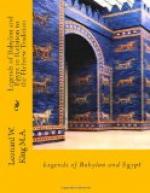(1) This illustrates the damage the Tigris itself is capable of inflicting on the country. It may be added that Sir William Willcocks proposes to control the Tigris floods by an escape into the Tharthar depression, a great salt pan at the tail of Wadi Tharthar, which lies 14 ft. below sea level and is 200 ft. lower than the flood-level of the Tigris some thirty-two miles away. The escape would leave the Tigris to the S. of Samarra, the proposed Beled Barrage being built below it and up-stream of “Nimrod’s Dam”. The Tharthar escape would drain into the Euphrates, and the latter’s Habbaniyah escape would receive any surplus water from the Tigris, a second barrage being thrown across the Euphrates up-stream of Fallujah, where there is an outcrop of limestone near the head of the Sakhlawiyah Canal. The Tharthar depression, besides disposing of the Tigris flood- water, would thus probably feed the Euphrates; and a second barrage on the Tigris, to be built at Kut, would supply water to the Shatt el-Hai. When the country is freed from danger of flood, the Baghdad Railway could be run through the cultivated land instead of through the eastern desert; see Willcocks, The Near East, Oct. 6, 1916 (Vol. XI, No. 283), p. 545 f.
(2) It was then that Sir William Willcocks designed the new Hindiyah Barrage, which was completed in 1913. The Hindiyah branch, to-day the main stream of the Euphrates, is the old low-lying Pallacopas Canal, which branched westward above Babylon and discharged its waters into the western marshes. In antiquity the head of this branch had to be opened in high floods and then closed again immediately after the flood to keep the main stream full past Babylon, which entailed the employment of an enormous number of men. Alexander the Great’s first work in Babylonia was cutting a new head for the Pallacopas in solid ground, for hitherto it had been in sandy soil; and it was while reclaiming the marshes farther down-stream that he contracted the fever that killed him.
From this brief sketch of progressive disaster during the later historical period, the inevitable effect of neglected silt and flood, it will be gathered that the two great rivers of Mesopotamia present a very strong contrast to the Nile. For during the same period of misgovernment and neglect in Egypt the Nile did not turn its valley and delta into a desert. On the Tigris and Euphrates, during ages when the earliest dwellers on their banks were struggling to make effective their first efforts at control, the waters must often have regained the upper hand. Under such conditions the story of a great flood in the past would not be likely to die out in the future; the tradition would tend to gather illustrative detail suggested by later experience. Our new text reveals the Deluge tradition in Mesopotamia at an early stage of its development, and incidentally shows us that there is no need to postulate for its origin any convulsion of nature or even a series of seismic shocks accompanied by cyclone in the Persian Gulf.




